The best bass fishing rig is the texas rig because it is the most versatile and simplest.
Soft plastic baits are one of the most valuable items a bass fishing angler can have. They offer a soft yet durable lure that closely mimics some of the favorite prey that bass like to target. It’s important to have a good understanding of the different rigs for bass that many of the professional anglers use to catch fish in a variety of different conditions throughout the entire year.
Here is an overview of some of the best rigs for bass that you can use to catch fish using soft plastic baits any time you go fishing.
| Bass Rig | Best Time to Use | Star Rating |
|---|---|---|
| Texas Rig | All year round; especially effective in weedy or heavy cover situations. | ⭐⭐⭐⭐⭐ |
| Carolina Rig | Early summer and fall; best for covering large areas of water. | ⭐⭐⭐⭐ |
| Wacky Rig | Spring and early summer; excellent in clear water and heavy cover. | ⭐⭐⭐⭐ |
| Drop Shot Rig | All year round; exceptional during post spawn and when bass are suspended. | ⭐⭐⭐⭐ |
| Neko Rig | All year round; outstanding during post spawn and in clear water. | ⭐⭐⭐⭐ |
| Tokyo Rig | Spring to fall; ideal in heavy cover and when punching through vegetation. | ⭐⭐⭐⭐ |
| Chicken Rig | Less conventional, but can be effective all year round; particularly good for skittish bass. | ⭐⭐⭐ |
| Split-shot Rig | All year round; particularly good in calm water and for pressured or spooky fish. | ⭐⭐⭐ |
| Fluke Rig | All year round; particularly effective during the post spawn period. | ⭐⭐⭐ |
This article is part of my Complete Guide to Bass Fishing series that you might be interested in.
Table of Contents
1. Texas Rig
The Texas rig is quite possibly the most versatile and commonly used bass fishing rig today. It’s very simple and can be used virtually any time of year to get bites from hungry bass in shallow or deep water situations.
This rig consists of a bullet sinker, offset shank hook and your choice of soft plastic bait. Most anglers opt for soft plastic worms when using the Texas rig, but there are a wide variety of different creature baits that also work very well, depending on the time of year you’re fishing. You can initiate strikes from hungry bass by methodically bouncing or dragging it along the bottom.
The Texas rig is a great choice of lure for fishing in and around heavy cover because it’s completely weedless and also has a very narrow profile that lets it slip easily up and over tangled brush, grass or thick vegetation. If you’re going to fish it around heavy cover, be sure to use braided line that will allow you to pull the rig free if it does happen to get snagged.

2. Carolina Rig
The Carolina rig has many similarities to the Texas style rig. The main difference is that the sinker is usually placed anywhere from about 18 to 24 inches in front of the actual soft plastic worm. The worm, or other type of soft plastic bait of your choice, is recommended to be rigged “Texas style” which means you’ll run the offset shank hook through the bait in the same way you would for the Texas rig, burying the tip of the hook in the plastic.
You can attach the sinker closer or farther away from the hook, but it’s best to use a barrel swivel to connect the line and hook past the sinker to prevent tangles in the line. The Carolina rig allows the soft plastic bait of your choice to float slightly above the bottom. This makes it much more visible to any nearby fish and is great for fishing around deep or shallow water grass beds.
Like the Texas rig, you can drag or bounce it along to draw strikes from bass. The Carolina rig is a great choice for covering areas like primary and secondary points to locate fish, especially during the early spring when they move into the shallows during the prespawn stage.
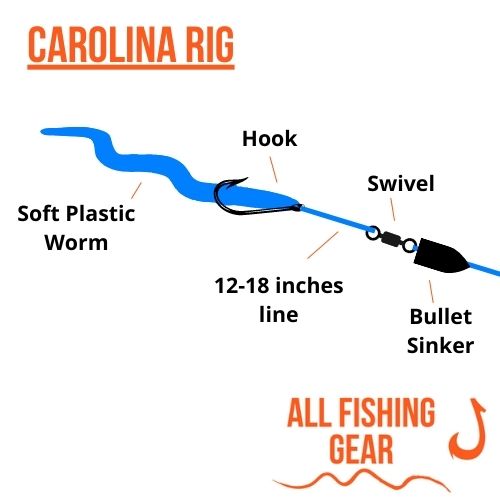
3. Wacky Rig
The wacky rig is one of the most productive methods of enticing fish to come out of heavy cover when bass are hidden deep inside brush piles, vegetation and other types of cover. It’s a fairly simple lure presentation that involves a wacky rig hook, plastic O-ring and your choice of soft plastic worm.
Most anglers tend to use a Senko worm for wacky rigs because it has a good amount of stiffness and provides the right type of wiggling motion that draws bass in to strike. The wacky rig is meant to look like a small bait fish suspending or swimming in the water, which taps into the bass’ instinctual drive to eat anything that presents itself as an easy meal.
Wacky rigs are best fished with a light spinning rod and reel with 8 to 10 pound test fluorocarbon line. You can throw a wacky rig near heavy cover or above brush piles and grass or vegetation on the bottom to draw bass out for a bite, especially on days when fish are a bit reclusive.
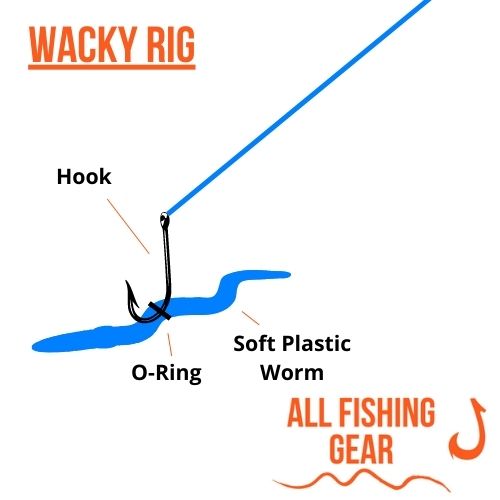
4. Drop Shot Rig
The Drop Shot rig is an excellent way to target fish deep down in cover, but it also works well in shallow water scenarios. This rig consists of a drop shot sinker connected to the end of your line with a hook fastened to the main line using a palomar knot. The hook can be baited with your choice of soft plastic worm or minnow bait, depending on the type of presentation you’re looking to have.
The Drop Shot rig is perfect for fishing deep water channels or areas where bass are at or near the bottom. Anglers have had huge amounts of success drop shotting down into brush piles or piles of logs, rocks or other structure on the bottom where big bass like to hide.
Most anglers like to use the Drop Shot rig when bass are deeper in the water column, such as the middle of summer or winter. However, the Drop Shot also works well when it is cast into areas near the shore and worked back towards the boat. This rig is also highly productive in some cases for catching bedded bass as the Drop Shot allows you to keep the lure in the bed for a long period to draw a strike.
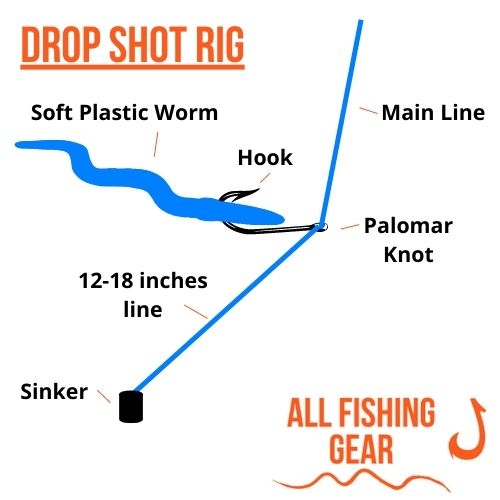
5. Neko Rig
The Neko rig is a somewhat new bass fishing technique with soft plastics very similar to the wacky rig in many ways. In fact the use of the O-ring and the type of hook are the same in both the wacky rig and Neko rig. The main difference is the small nail weight or other type of weight inserted into the worm’s nose while the O-ring is moved slightly toward the weighted side of the worm.
This presentation shows a small bait fish swimming along with its nose turned down toward the bottom. It very closely mimics the way a real bait fish forages along the bottom of lakes or rivers and offers a huge advantage to bass anglers who want to take advantage of sluggish or even aggressive fish.
You can fish the Neko rig as slow or as fast as you want and it’s a great method to cover a large area of water to locate where bass are and pinpoint your efforts on that specific location. The Neko rig is a great choice for spring, summer and fall when bass are generally in shallow areas searching for small bait fish to devour.
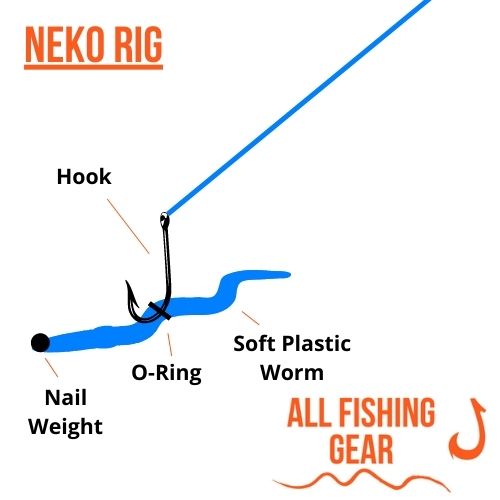
6. Chicken Rig
One of the newer, up-and-coming types of rigs for bass is the Chicken rig. This has many similarities to the Neko rig in, but creates a presentation that can be fished more slowly. The Chicken rig consists of a 1/0, 2/0 or 3/0 straight shank worm hook, the soft plastic worm of your choice and a weight inserted into the ‘head’ of the worm. This weight can be the same type used for the Neko, or you can create your own out of a small nail or screw, which will help the Chicken rig stand on end to a better degree.
To create the Chicken rig, you’ll want to hook your worm on the straight shank hook in a Texas style manner, which buries the tip of the hook within the worm’s body. This makes it weedless and allows you to fish the Chicken rig in areas with heavy cover where the Neko rig will get snagged.
You can fish the Chicken rig in both shallow or deep water to catch bass that are at or near the bottom. It’s a great choice to draw strikes from bass moving up into the shallows during the prespawn stage and also works well during the summer to catch bass along primary and secondary points.
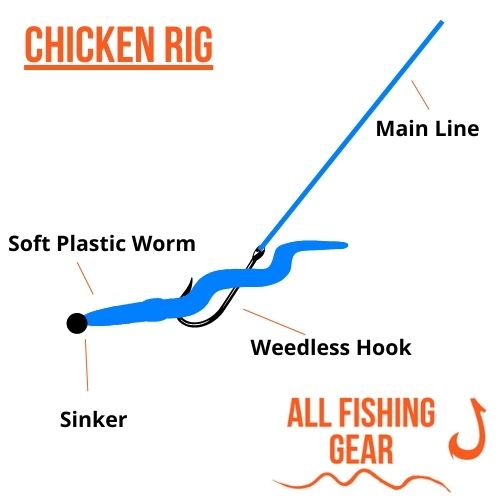
7. Split-Shot Rig
The Split-Shot rig is mostly considered an outdated bass fishing technique as more anglers have opted for the Drop Shot or Shaky Head rigs instead. However, this rig is still highly productive and works well in shallow or deep water virtually any time of the year.
The Split-Shot rig is very simple to create and consists of a split-shot sinker, a 2/0 or 3/0 worm hook, and the worm you choose. You can use a larger or smaller version of the Split-Shot by using heavier weights, larger hooks and bigger worms, depending on the presentation you’re looking to have.
The split-shot sinker can be placed anywhere you want on the line, but most anglers like to have it anywhere from 18 to 24 inches above the hook. This allows the worm to float off the bottom and is more visible to nearby fish. It’s best to fish a Split-Shot rig with a light spinning rod, reel, and 8 to 10 pound fluorocarbon or monofilament line. The rig can be dragged across the bottom quickly or slowly to draw strikes.
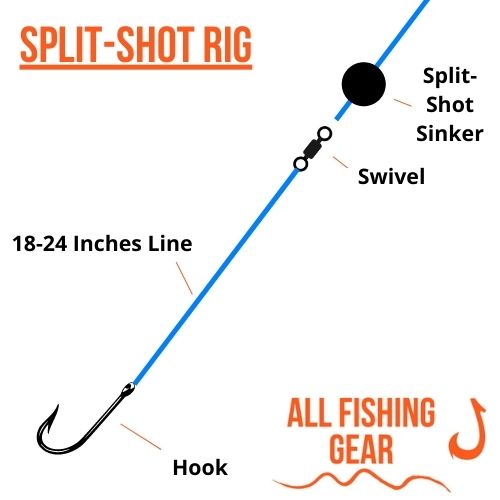
8. Tokyo Rig
One of the more overlooked or lesser-known rigs for bass is the Tokyo rig. This is a fairly new style of fishing that draws a lot of similarities to the Texas rig, but keeps the bait off the bottom using an interesting weight that’s connected with a wire. The Tokyo rig is sometimes better than a Texas or Carolina rig because it keeps your bait off the bottom and allows it to have more action, which sometimes works in your favor to attract bites.
The Tokyo rig is made up of a specialized product made by VMC, which is essentially a short, 3-inch-long wire and sinker that connects to an offset shank hook, which is fastened to a barrel swivel. You’ll want to rig the worm in a Texas style that makes it weedless and you can use either worms, flukes or creature baits depending on the presentation you want.
The Tokyo rig is great for fishing at nearly any time of year to catch bass in shallow or deep water. It’s a novel approach to soft plastic bait rigs for bass that’s very unique and might draw a bite or two from bigger bass who are not used to seeing it.

9. Fluke Rigs
There are a few different ways to rig a fluke for bass that will work in a variety of situations. The Zoom Super Fluke has been a revolutionary type of lure that other manufacturers have sought to recreate with varying levels of success. It’s a must-have soft plastic bait for serious bass anglers and works exceptionally well to catch big bass.
The weighted and weightless style of rigging a fluke are two of the most popular ways to fish this soft plastic bait. However, many anglers rely on an underspin or even a shaky head approach if bass are staging in different parts of the water column.
A fluke is an outstanding choice of soft plastic bait when bass are focused on eating small bait fish like minnows or shad and can be the difference-maker between catching a limit or not getting a single bite in some cases.
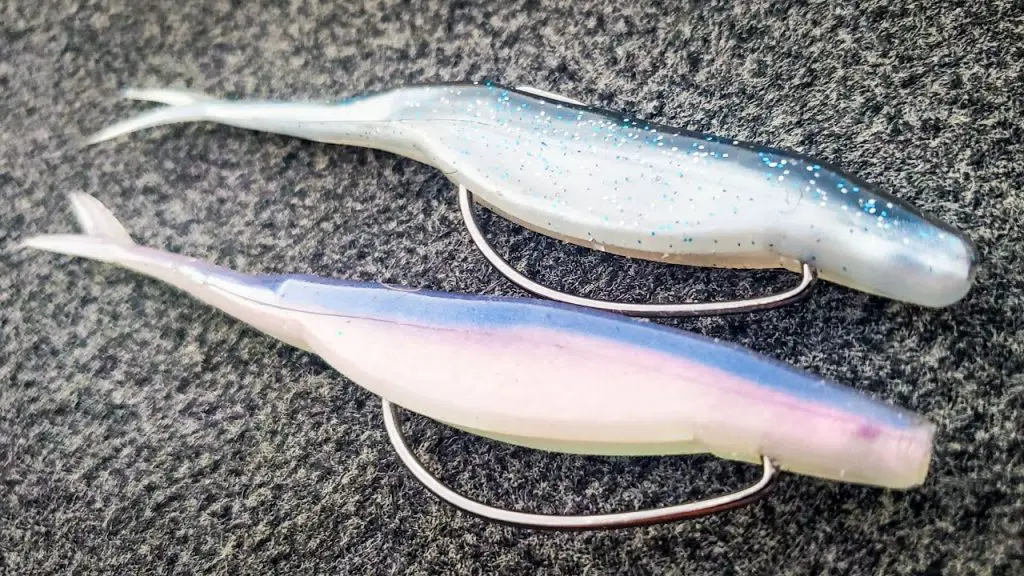
Conclusion
These techniques represent the most commonly-used rigs for bass and should be part of any serious angler’s fishing arsenal when it comes to using soft plastic lures. By experimenting with each type of rig, you can expand your knowledge and understanding of what makes bass bite at certain times of the year. An example you may not have heard of is the Inu Rig which consists of shaping the worm rig into an S shape.
By using these rigs for bass fishing, you can develop your own techniques and tactics that work for catching bass in every season.
